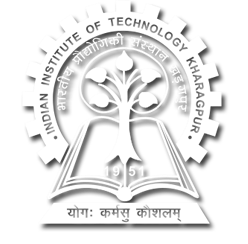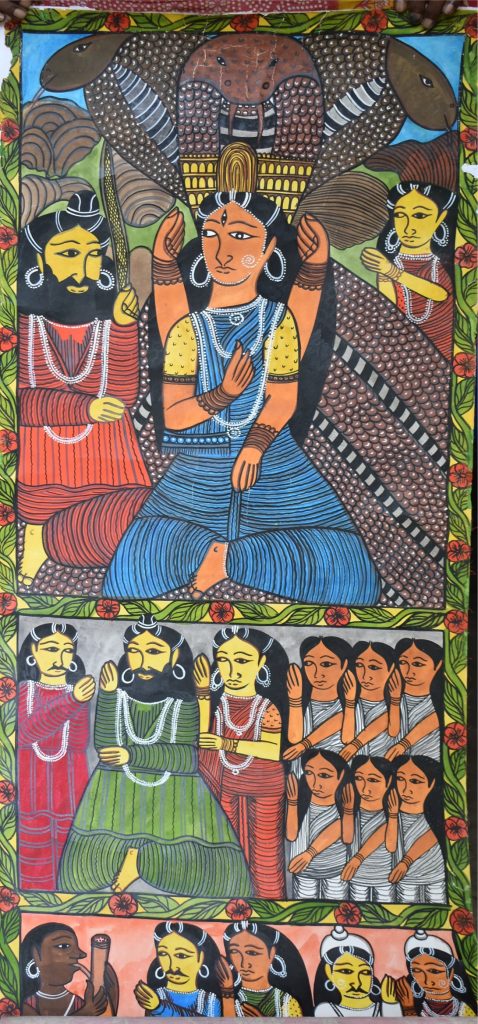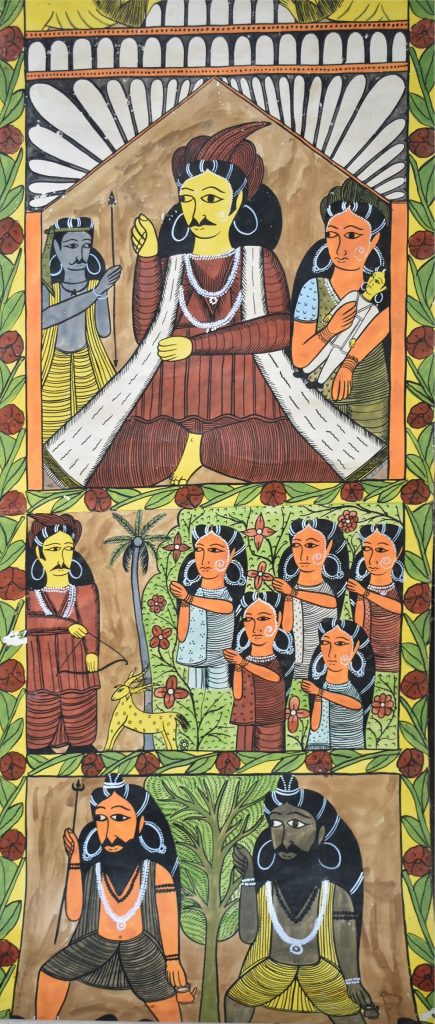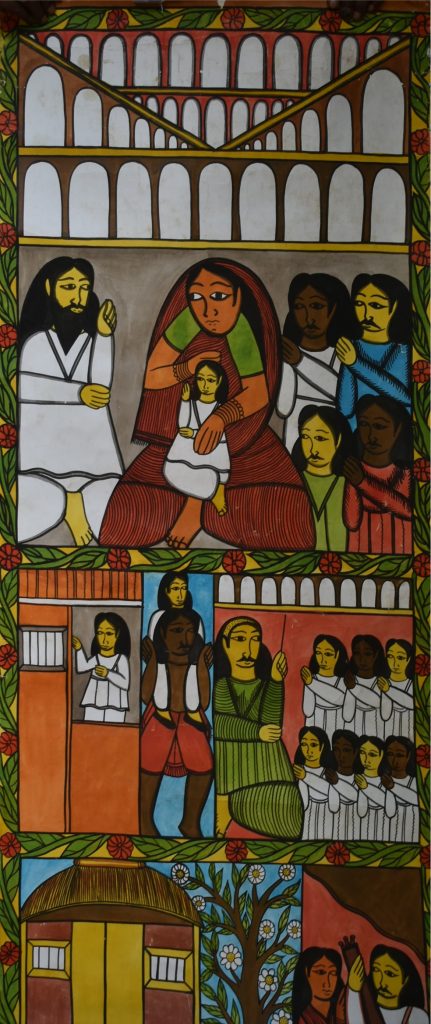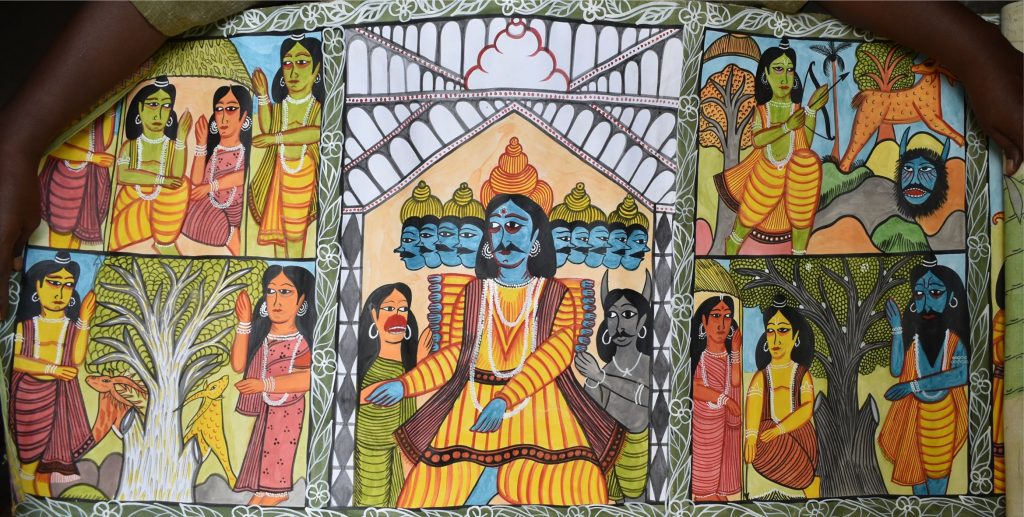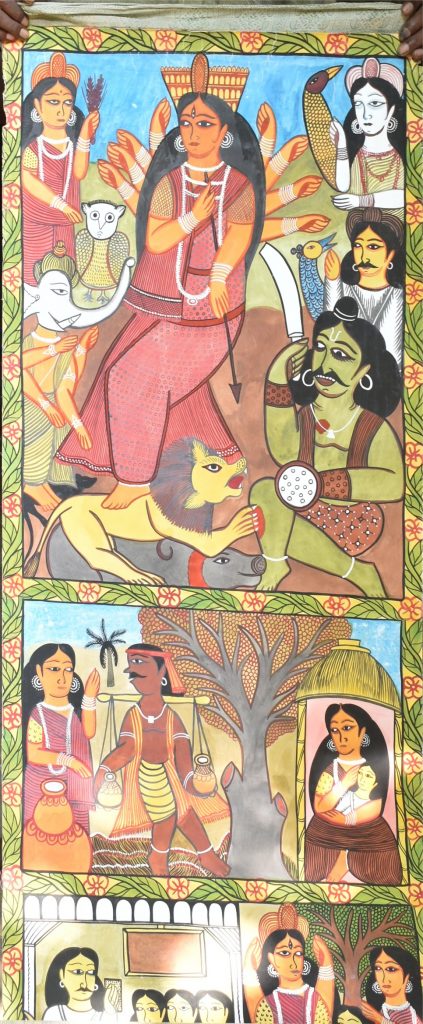Transcript
Interviewer: How long have patuas been living here?
Gurupada Chitrakar: Patuas have been living in Naya, Pingla for about eighty to eighty-five years. Before that, patuas didn’t live here, but in various other places. They gradually migrated to this village and now the population has increased manifold. The number of patua families staying here is around eighty. In total, there might be more or less 325 patuas here.
Interviewer: Where have they migrated from? Purba Medinipur?
Gurupada Chitrakar: Yes. They have, by and large, migrated from Purba Medinipur. Back in those times, there was just one undivided Medinipur. Now we have these divisions. We are from Paschim or West Medinipur and they are from Purba Medinipur. So, patuas came from that part of the district, especially from places like Thekuachawk, Hanshchawra, Keshavbar. There’s a beautiful narrative of how patuas came over to this place and settled down. Nowadays, we travel all the way to Kolkata in the morning, finish our work, and come back by the evening. The means of communication have improved a lot. Back in those days, we didn’t have so many varied modes of transportation. We had to travel either by foot, or in a bullock cart. Now, patachitra is a form of an entertainment. Earlier, it used to be displayed in different villages. Even till this date, it is displayed in villages in a similar manner, though not that frequently. The themes usually range from the epics – the Mahabharata to the Ramayana, from the Mangal Kavya to the Mangal Chandi. While wandering about villages with their patachitra, the patuas came across the Vishaal family, here at Naya, Pingla. In contemporary society, the Vishaal family was pretty rich. They owned quite a few acres of land. They were not as wealthy as a zamindar. They belonged to a rung lower than that perhaps. Patuas, in those times, were highly respected and loved by all. Even now, you won’t find a single community that looks down upon patuas.
As patuas began travelling this far, it became increasingly difficult for them to go back home to Thekuachawk. That is when the Vishaals began to put up the patuas in their spacious rooms. The patuas would come to Naya, stay here for eight to ten days, earn as much as possible, and then go back to their places. The Vishaal family started enquiring as to why they needed to travel to and fro for their earning. Compared to Purba Medinipur, the prospect of earning was much better here, in Paschim Medinipur. So, the Vishaal family gave away some land to the patuas and asked them to settle down. There’s a Muslim belt situated within a distance of a kilometre from here. Even the Muslims loved our community a lot. These Muslims also gave away bamboo, hay for building houses. In fact, they brought all these raw materials on their bullock carts and even provided manpower as the patuas were trying to construct their houses. So, that is how it began. A few patuas started to settle down here and now the total number of patua families is around eighty. The patuas don’t live on others’ property now. They have bought their own lands.
Interviewer: When did your family move to Naya?
Gurupada Chitrakar: My paternal family used to live in Shobong. This is my maternal uncle’s place. My father was not that closely associated with patachitra. He could paint and also knew a few pata songs, though. But the songs he knew were very few. He was a mechanic. My maternal family has always been a family of patuas. I was born and brought up here. I have five older sisters. They, too, were born and brought up here. Now I am 53.
Interviewer: What are the changes that you see in the practice of patachitra nowadays? Has the number increased or decreased? In what way have you seen patachitra evolve since your childhood?
Gurupada Chitrakar: There are two sides to the story. The number of patuas have increased but the feeling of brotherhood has decreased. The number of painters have increased but the songs have decreased. The market value has increased but the sense of satisfaction has decreased. Back then, their market value was comparatively less but the idea of brotherhood amongst the patuas was very strong. People were poor then but they had an abundance of love. These are the two sides. So, with the increase in the number of patuas, the sense of fraternity, the songs, everything seems to have diminished. Patuas have won world-wide fame. Starting from a small village like Naya, patuas have carved out a niche for themselves not only in the national but also in the international domain. But what I personally feel is that the strong bonding between us has got affected. We are earning a lot and yet our thirst for materialistic things seems insatiable. I might sell off a pata for a hefty sum (one lakh rupees) but the very next day I might regret my decision. At the back of my mind, I might keep contemplating that I could have sold it for yet another lakh. This demand, therefore, never gets quenched.
Interviewer: You said that you have learnt patachitra from your maternal uncle. So, ten or fifteen years back, what were the common themes in patachitra?
Gurupada Chitrakar: Themes usually pertained to mythology. As I have already mentioned, they were related to the Mangal Kavya, Mangal Chandi, the epics – the Ramayana, the Mahabharata. However, topics revolving around nature, environment and health were also present. The number of mythological patas was more in comparison to the contemporary social patas. Nowadays, the mythological still exists, but the latter has slightly increased in number. We have patas on health related issues, on issues pertaining to the environment, pollution, natural calamities.
Interviewer: While speaking to another patua, we got to know that patuas receive a monthly stipend from the government to compose patas on certain themes and to promote certain ideas. In that case, where does the interest of the patua lie – in the mythological patas or the social, contemporary ones?
Gurupada Chitrakar: The person you have interviewed has given you absolutely correct information. We receive a monthly stipend from the government. The current Chief Minister Honourable Ms. Mamata Banerjee has made sure that the status of artists gets elevated; she has paid extra attention to all genres of art. This is my personal opinion. We, the patuas receive a monthly stipend. I presume other artists. too, are receiving a certain amount from the government, though I won’t be able to furnish you with all the factual details. Composing patachitras on certain topics, trying to promote certain ideas is a very contemporary thing. It has been practiced only in recent times. This is the opinion of the other person you have interviewed. Now let me tell you what I feel. Whenever a significant event occurs, I start composing songs – the tune, the lyrics. Whenever I come across a certain event, and I feel that people might be entertained or benefited from this, I start composing songs, painting patas and singing aloud. If any patua would want to learn that song from me, I wouldn’t sell it. Earlier patuas never sold their songs. They would simply pass down a song from generation to generation – much like the teacher-disciple relationship. I have been able to hold onto this practice. I don’t know how long I’ll be able to maintain this in this society of insatiable materialistic thirst. I had learnt this from my guru. I had learnt it for a vocational purpose, and there was no monetary transaction between my guru and me. If someone comes to me and asks for the songs that I have composed, I teach them my songs free of cost. I also narrate how the accompanying picture ought to be so that there’s some parity between the picture and the song. I don’t know how long I’ll be able to hold onto this practice. But if someone dictates to me to do a particular patachitra, I will never be able to do that. I have never painted that way. I never will. I had composed a song on the topic ‘pulse polio’ long back. We didn’t have television in those days. We had radio sets. An advertisement regarding pulse polio used to be aired where Mr. Amitabh Bachhan spoke about the absolute need for polio vaccination. Even before those advertisements were aired, we, the patuas, had composed songs on this and used to wander about villages educating people about the same. We were also offered work by the former Left government. Not just me, but some other patuas as well. We had to promote awareness about some lesser worked upon areas like polio vaccination. But we were not dictated to by the government as to what had to be painted. I had done the work completely from my own perspective. Even now, whenever I come across a significant event, I compose the song first. If the songs get accepted, then that’s great. If they cannot, honestly, I don’t mind.
In the year 1992, on the day the Babri Masjid/Ram Mandir got demolished, I was in Jorasanko, Kolkata. All of a sudden a huge commotion was created. There was bombing, counter-lathi-charge by the police. I boarded a bus and was trying to get to Howrah. But the conductor said that the bus wouldn’t be going to Howrah; it would be going to Salt Lake. He also asked me not to get down because the situation was getting worse. So, I went to Salt Lake and put up at a relative’s place for four days. Communication wasn’t that good, back in those days. My family got extremely worried. They were nervous that I might have got caught in this volatile situation and perhaps lost my life. The entire experience made me compose a song – ‘Not hatred, but harmony’. After four days, the curfew was withdrawn, and normalcy gradually got restored. I came back home that night. The very next morning, I went to a tea-stall here and began to discuss the entire event there. I sang the song I had composed in front of the Gram Panchayat (the Head of the village). He seemed so impressed that he took me to the Block Development Officer. The latter heard me sing and remarked that this song was of utmost importance given the current scenario. He drove me to the District Magistrate’s office. When I sang what I had composed, he said that I should immediately be sent off to villages to promote the notion of communal harmony. I visited several places for this purpose. There were several others too, who were appointed for the same. But the main point is that I was never dictated to by someone else as to what should be the theme of my pata. I also created a patachitra on HIV/AIDS. In fact, I participated in several programmes, and have travelled to places like Delhi, Mumbai, Bangalore. I have also visited South Africa, a country which has the highest number of HIV infected people. I have been to UCLA University, Los Angeles, USA.
So, I come across certain events. I compose songs and if the media accepts it, the patachitra and songs are used for promoting awareness about certain ideas.
Interviewer: Okay. You compose the songs first. Once that is done, you paint accordingly.
Gurupada Chitrakar: Yes. The songs come first, and then come the paintings. I don’t know who are the people you have interviewed so far. But all these songs which are used for promotional purposes have been composed by me. I have songs on personal hygiene (the use of toilets), gender equality, prohibition of child marriage.
Interviewer: Coming to pata songs, especially the mythological ones, has there been any revision in the lyrics or even the tune of the songs which you have learnt from your forefathers?
Gurupada Chitrakar: Firstly, meddling with tradition is forbidden. Whatever our forefathers have written was not incorrect. The lyrics were not incorrect. Even the tune was not incorrect. This is what I personally feel. I don’t know what the others think. Our opinions may vary. But I believe, nothing was out of place – neither the lyrics nor the tune.
Interviewer: The mythological patachitras were handed down by your predecessors. But as regards the social, contemporary patas, which are the patachitras that were your brainchild?
Gurupada Chitrakar: As I already mentioned, I have composed patas on topics like HIV, polio vaccination, communal harmony, personal hygiene (the use of toilets), prohibition of child marriage, gender equality. All these patachitras have an educational value as well as an entertaining value. Anyone who hears them would like them.
Interviewer: What do you think? Which has a greater market demand – the mythological patas or the ones on social contemporary issues?
Gurupada Chitrakar: Both are good. The market demand is high for both these patachitras. On the other hand, it can also be said that there’s no demand for either of these. If, for instance, a patua sings only at social events, s/he will be asked to leave the stage. But then another patua might perform a song at yet another social event and garner great appreciation. The fact is that music is God-gifted. You cannot be an artist until and unless the Goddess of Music (Saraswati) showers you with her blessings. If a gifted patua begins singing, he’d be able to capture the attention of a huge audience. But if he cannot sing, even a crowded auditorium would start thinning. So, both mythological and social patas have an equal demand. Both are good.
Interviewer: Do you believe that your next generation would continue with the tradition of patachitra?
Gurupada Chitrakar: In my opinion, it’s pretty difficult. Firstly, the way our predecessors have toiled, or even the hardships that we had to face was immense. I won’t comment about others. I’d reserve my comments only for my sons. I have got three sons. They know the songs. But honestly, if they start singing, everyone would flee. Judging from that point of view, the survival of patachitra would be a miracle. We have a huge fair every year – thePotmaya. There at Potmaya, we once found a person in a prim and proper dress – wearing a suit, tie, boots and glasses. He suddenly got up on the stage and started performing. We realised that he was a baul (itinerant singer). So the essence of baul was completely missing. This is how things would gradually turn into. Even many patuas have become like this. They are only bothered about the apparent glitz and glamour. So, I have severe doubts regarding how long they’ll be able to maintain the tradition, or how exactly will they be able to contribute to the next generation.
Interview: How do you feel about this gradual change that the patachitra is undergoing – this entire journey from patas to graphic t-shirts?
Gurupada Chitrakar: It would get extinct very soon. As I have said, the income might have increased but the pursuit for materialistic pleasures has increased too. What would they contribute to the next generation? Are we only occupied with ourselves? Are we doing this only for ourselves? Had our forefathers been this selfish, we would never have achieved this status, this position.
That is why I have written a few lines…
Please think over it and answer… What have you given to society?
The fathers of all daughters are dying a slow death. Their daughters would have to move to their in-laws’ house.
Society has given so much. Even then, how can someone ask for dowry?
This is such an embarrassing practice…
Gurupada Chitrakar: What have we given to this society? Women are at par with men. They are equally educated and have jobs. Women these days are working as pilots as well. Despite everything, some men still ask for dowry, for marrying such qualified women. Isn’t this shameful?
If you find a single meaningless word in my songs…. All the words are deeply meaningful and true. Otherwise, the entire structure would collapse. Also, people would pelt stones at me, during my stage performances, if I were to sing meaningless songs.
I won an award for this pata. This is based on the Manasa Mangal.
